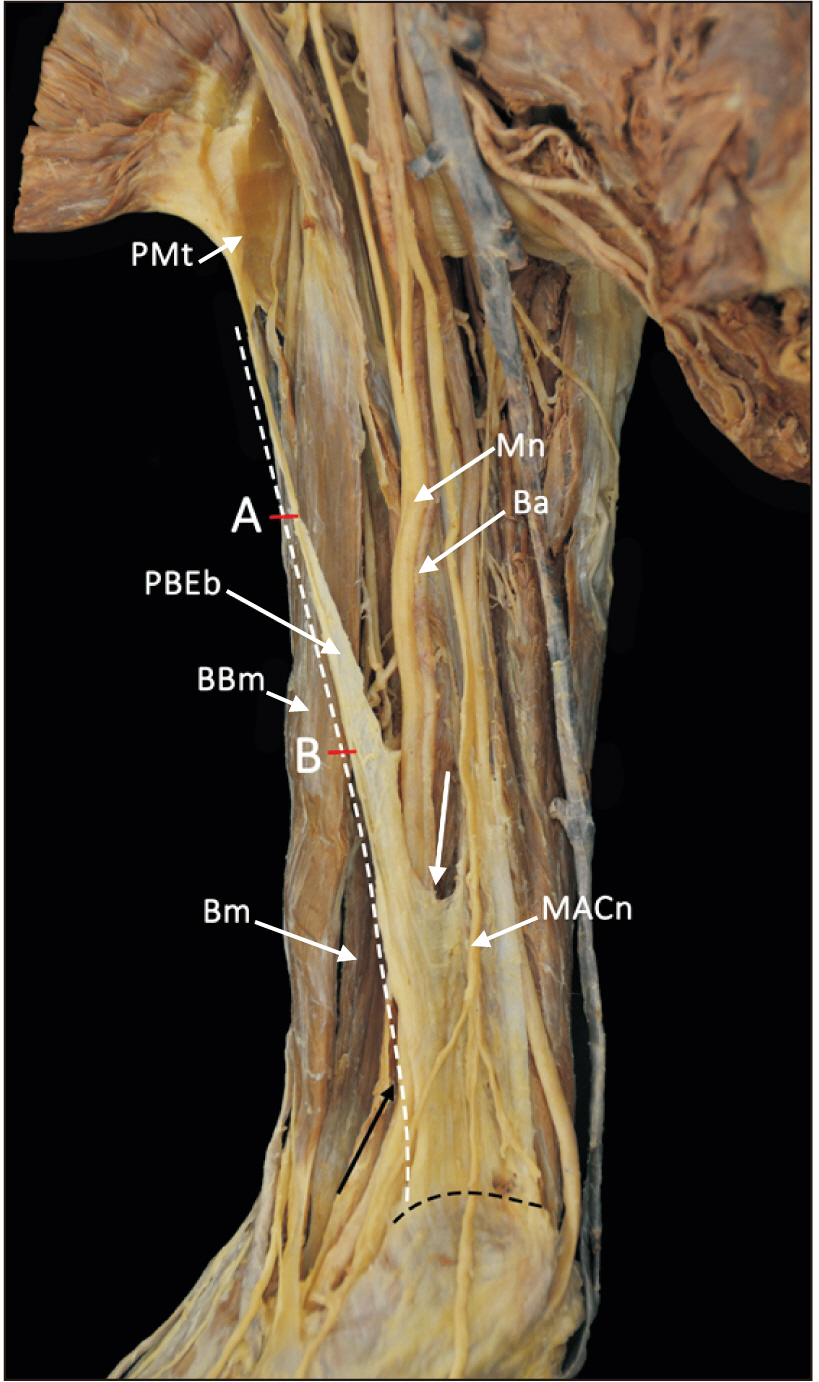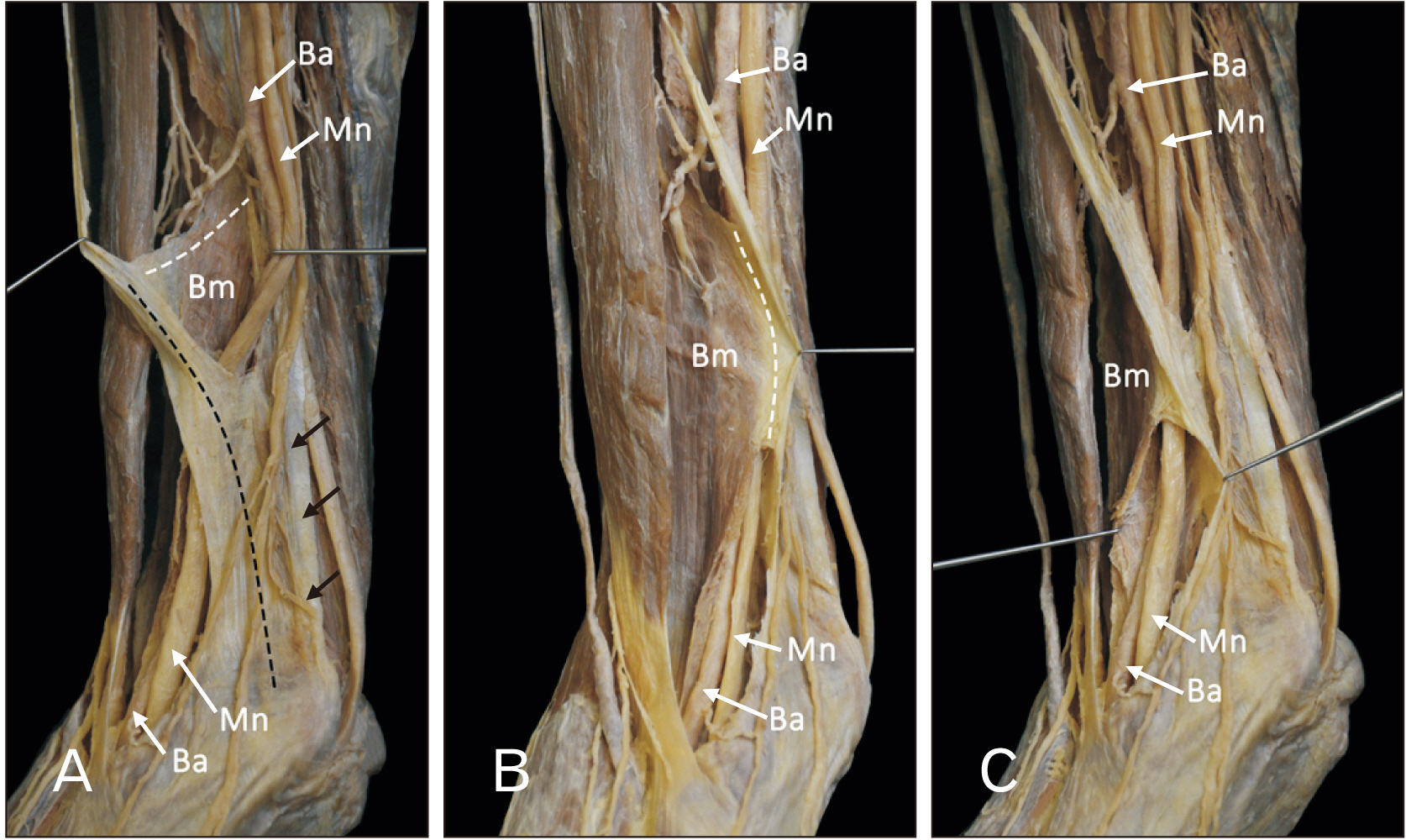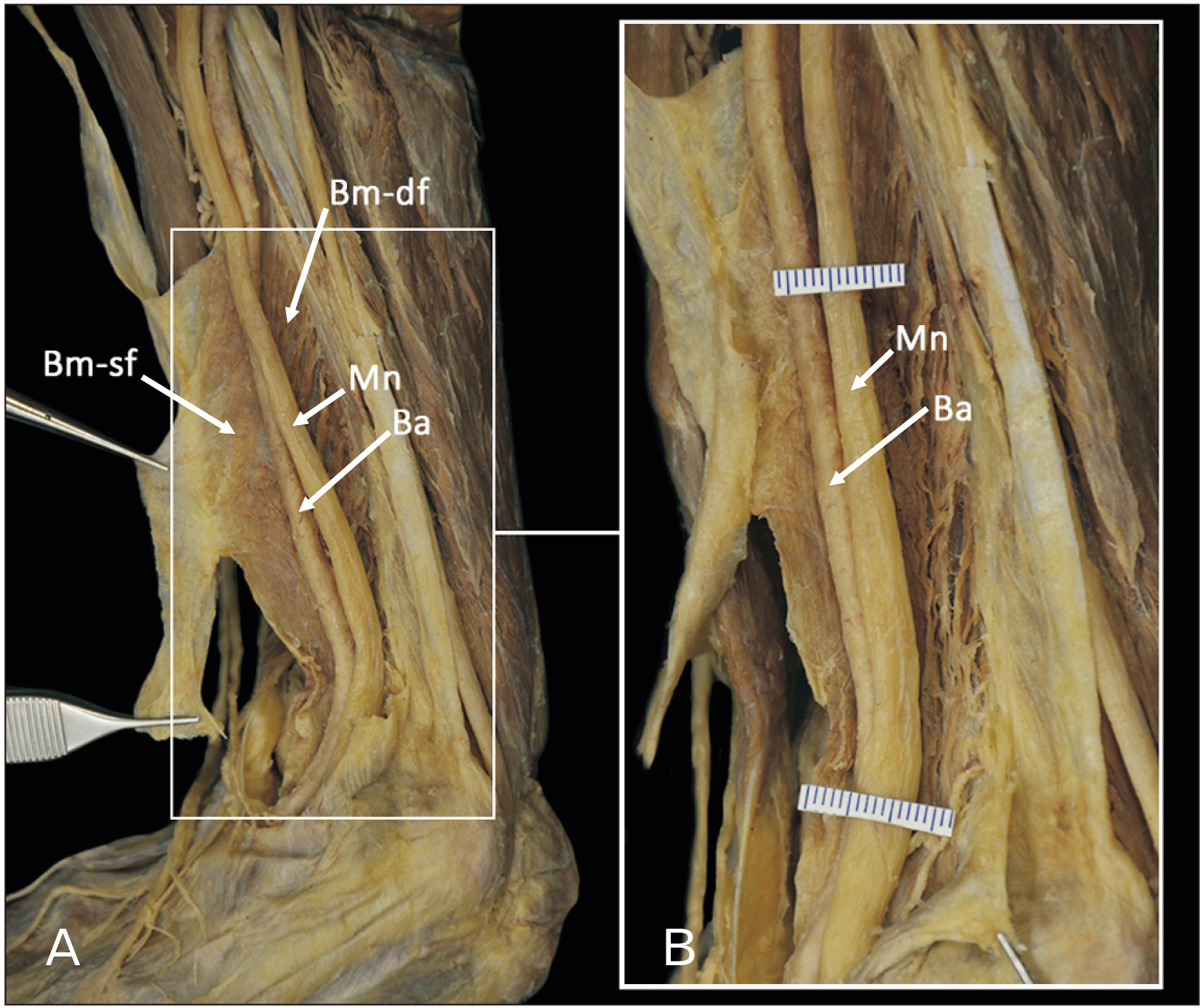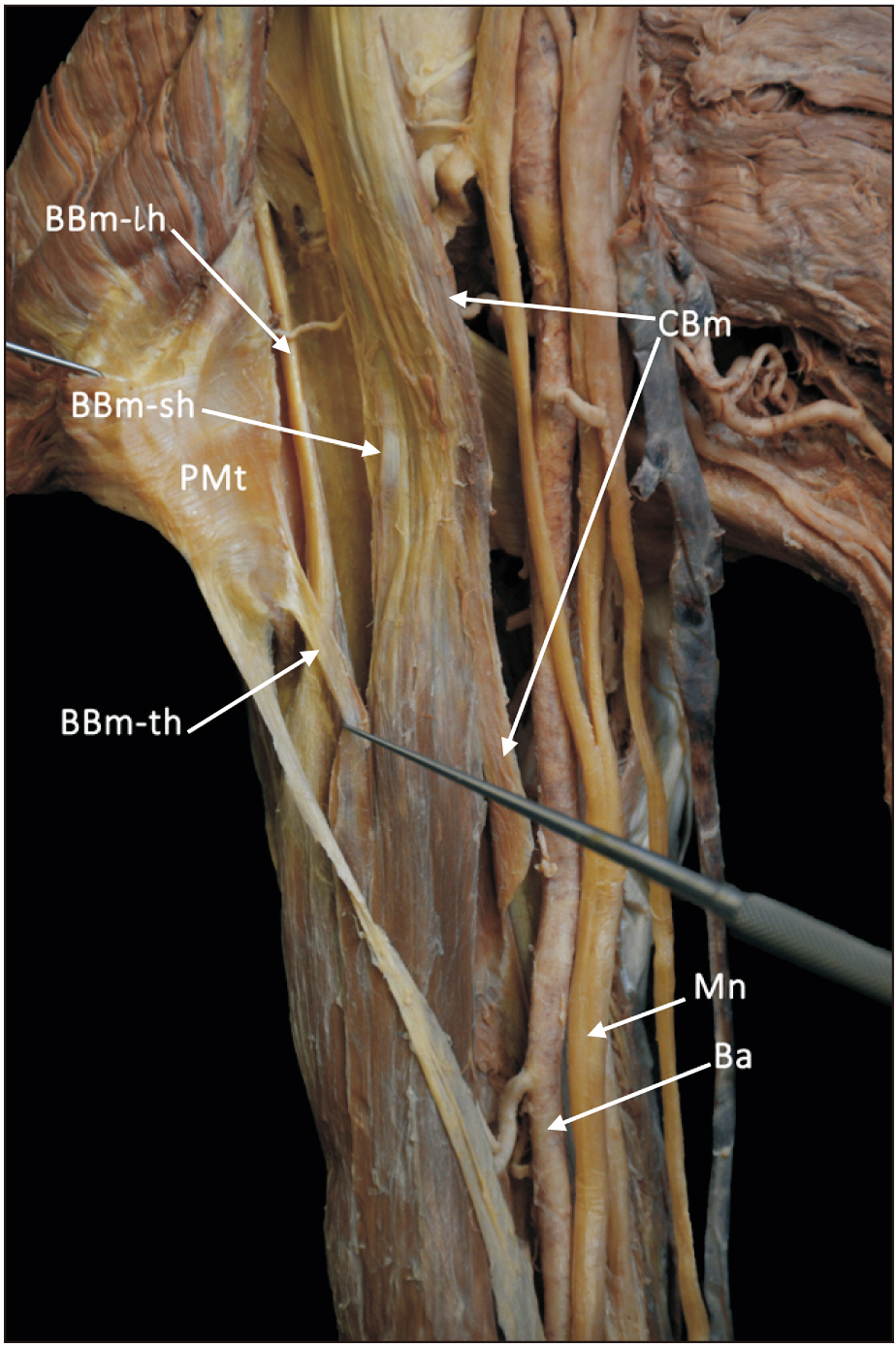Anat Cell Biol.
2023 Jun;56(2):280-284. 10.5115/acb.23.004.
Pectorobrachioepicondylaris musculoaponeurotic band: case description with evidence of median nerve compression
- Affiliations
-
- 1Department of Medical Sciences, Clinical Anatomy, Embryology and Neuroscience Research Group (NEOMA), Faculty of Medicine, University of Girona, Girona, Spain
- 2Department of Anatomy, Faculty of Medicine, Khon Kaen University, Khon Kaen, Thailand
- 3Department of Neurosurgery, Tulane Center for Clinical Neurosciences, Tulane University School of Medicine, New Orleans, LA, USA
- 4Department of Neurology, Tulane Center for Clinical Neurosciences, Tulane University School of Medicine, New Orleans, LA, USA
- 5Department of Structural & Cellular Biology, Tulane University School of Medicine, New Orleans, LA, USA
- 6Department of Oral and Maxillofacial Anatomy, Graduate School of Medical and Dental Sciences, Tokyo Medical and Dental University, Tokyo, Japan
- 7Department of Anesthesiology, CEU-San Pablo University School of Medicine, Madrid-Montepríncipe University Hospital, Madrid, Spain
- 8Department of Anesthesiology, University of Florida College of Medicine, Gainesville, FL, USA
- 9Department of Human Anatomy and Embryology, Facultad de Medicina, Universidad Complutense de Madrid, Spain
- 10Department of Neurosurgery and Ochsner Neuroscience Institute, Ochsner Health System, New Orleans, LA, USA
- 11Department of Anatomical Sciences, St. George’s University, St. George’s, Grenada
- KMID: 2544092
- DOI: http://doi.org/10.5115/acb.23.004
Abstract
- Upper limb muscle variations can be encountered on imaging or at surgery. We report an unusual muscle and band found during routine dissection of the arm in a cadaver. This case is described and salient literature reviewed. A band was found that traveled from the insertion of the pectoralis major tendon distally and obliquely toward the medial intermuscular septum and medical epicondyle. Fibers of the brachialis were found to interdigitate into the band. A tunnel was formed that carried the median nerve and brachial vessels. Evidence of median nerve compression was observed. We considered this an example of a pectorobrachioepicondylaris muscle. However, some can lead to clinical presentations. Although the significance of the case reported herein is not certain, signs of median nerve compression were identified. We believe that the term pectorobrachioepicondylaris bests describes the muscle reported herein and that our case represents a previously unreported variant of this muscle.
Keyword
Figure
Reference
-
References
1. Wood J. 1867; IV. Variations in human myology observed during the Winter session of 1866-67 at King's college, London. Proc R Soc Lond. 15:518–46. DOI: 10.1098/rspl.1866.0119.
Article2. Loukas M, Tubbs RS. 2009; Musculus dorsoepitrochlearis. Clin Anat. 22:782. DOI: 10.1002/ca.20826. PMID: 19637307.
Article3. Macalister A. 1867; Further notes on muscular anomalies in human anatomy, and their bearing upon homotypical myology. Proc R Irish Acad. 10:121–64.4. Tubbs RS, Shoja MM, Loukas M. 2016. Bergman's comprehensive encyclopedia of human anatomic variation. John Wiley & Sons;DOI: 10.1002/9781118430309.5. Georgiev GP, Landzhov B, Tubbs RS. 2017; A novel type of coracobrachialis muscle variation and a proposed new classification. Cureus. 9:e1466. DOI: 10.7759/cureus.1466.
Article6. Iwanaga J, Singh V, Takeda S, Ogeng'o J, Kim HJ, Moryś J, Ravi KS, Ribatti D, Trainor PA, Sañudo JR, Apaydin N, Sharma A, Smith HF, Walocha JA, Hegazy AMS, Duparc F, Paulsen F, Del Sol M, Adds P, Louryan S, Fazan VPS, Boddeti RK, Tubbs RS. 2022; Standardized statement for the ethical use of human cadaveric tissues in anatomy research papers: recommendations from anatomical journal editors-in-chief. Clin Anat. 35:526–8. DOI: 10.1002/ca.23849. PMID: 35218594.7. Afroze MKH, Sangeeta M, Tiwari S. 2020; A case report of additional slip of pectoralis major- pectorotubero fascialis muscle. J Med Sci Health. 6:18–20. DOI: 10.46347/JMSH.2020.v06i01.004.8. Hartman CG, Straus WL. 1971. The anatomy of the rhesus monkey, Macaca mulatta. Hafner;DOI: 10.1038/134047a0.9. Palagama SP, Tedman RA, Barton MJ, Forwood MR. 2016; Bilateral chondroepitrochlearis muscle: case report, phylogenetic analysis, and clinical significance. Anat Res Int. 2016:5402081. DOI: 10.1155/2016/5402081. PMID: 27242928. PMCID: PMC4875967.
Article10. Loukas M, Louis RG Jr, Kwiatkowska M. 2005; Chondroepitrochlearis muscle, a case report and a suggested revision of the current nomenclature. Surg Radiol Anat. 27:354–6. DOI: 10.1007/s00276-005-0337-4. PMID: 15912263.
Article11. Kotian SR, Bhat KMR. 2013; Pectoro-epicondylaris: a rare extension of the pectoralis major muscle. Rev Argent Anat Clin. 5:29–32. DOI: 10.31051/1852.8023.v5.n1.14049. PMID: 5c2d606f1b1f4d548d21cffdc78310c0.12. Horrocks P, Hale White W, Lane WA. 1884; An account of the abnormalities observed in the dissecting room during the winter session 1882-1883. Guys Hosp Rep. 42:39–48.13. El-Naggar MM, Al-Saggaf S. 2004; Variant of the coracobrachialis muscle with a tunnel for the median nerve and brachial artery. Clin Anat. 17:139–43. DOI: 10.1002/ca.10213. PMID: 14974102.
Article14. Calori L. 1868; On important anomalies of bones, vessels, nerves and muscles observed in last two years doing human anatomy. Mem Acad Sci Bol. 8:417–82. Italian.15. Iwanaga J, Singh V, Ohtsuka A, Hwang Y, Kim HJ, Moryś J, Ravi KS, Ribatti D, Trainor PA, Sañudo JR, Apaydin N, Şengül G, Albertine KH, Walocha JA, Loukas M, Duparc F, Paulsen F, Del Sol M, Adds P, Hegazy A, Tubbs RS. 2021; Acknowledging the use of human cadaveric tissues in research papers: recommendations from anatomical journal editors. Clin Anat. 34:2–4. DOI: 10.1002/ca.23671. PMID: 32808702.
Article
- Full Text Links
- Actions
-
Cited
- CITED
-
- Close
- Share
- Similar articles
-
- Ultrasonography for nerve compression syndromes of the upper extremity
- The Anterior Interosseous Nerve Syndrome
- Ultrasonographic Study of Median Nerve after Carpal Tunnel Release
- A Schwannoma Originating from Median Nerve at Proximal Forearm Caused Ulnar Nerve Symptom by Compression
- Rare case of median nerve and brachial artery entrapment by an abnormal musculo-fascial tunnel in the arm: possible cause of neurovascular compression syndrome





